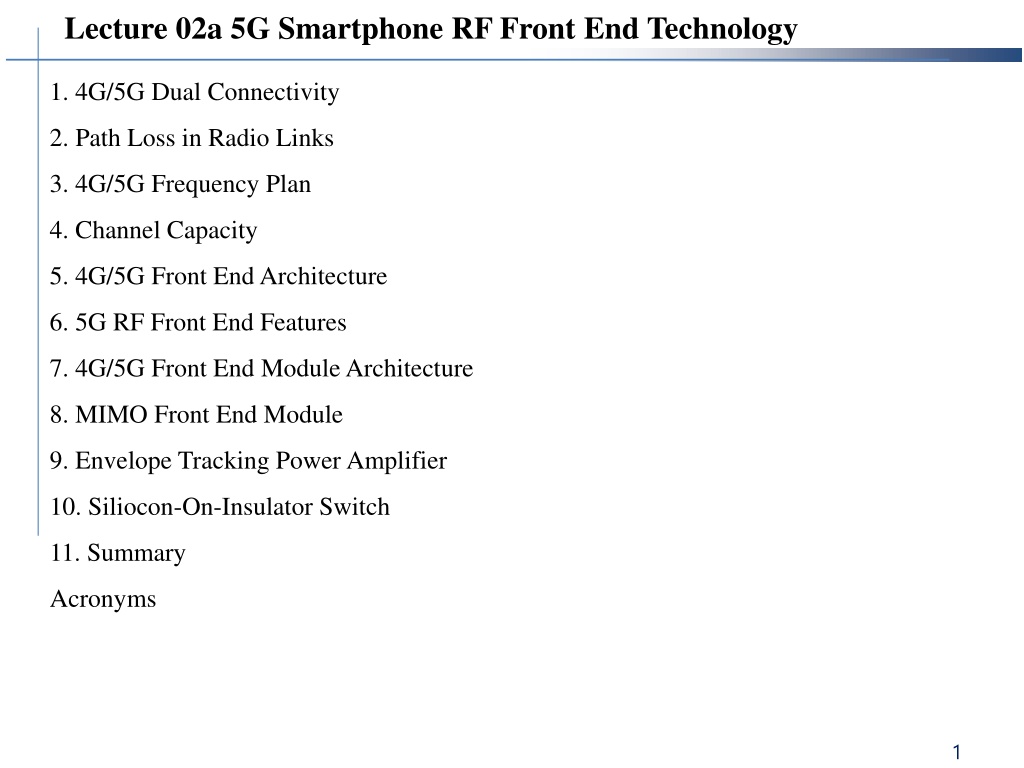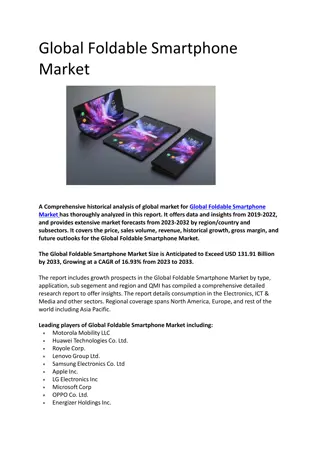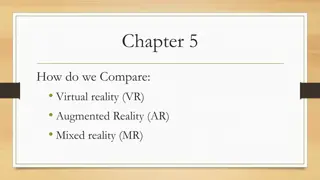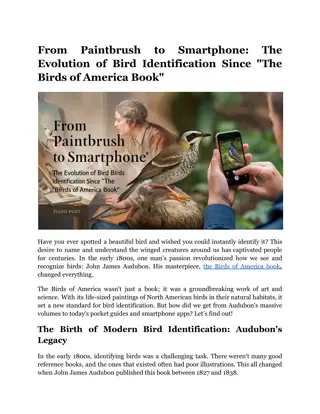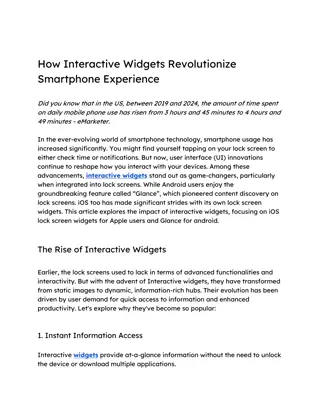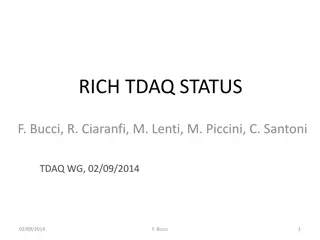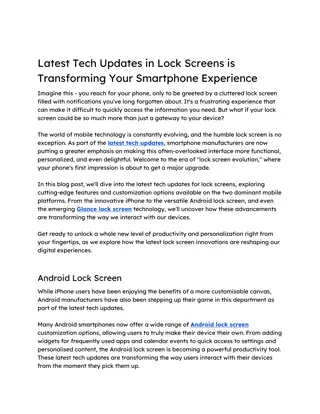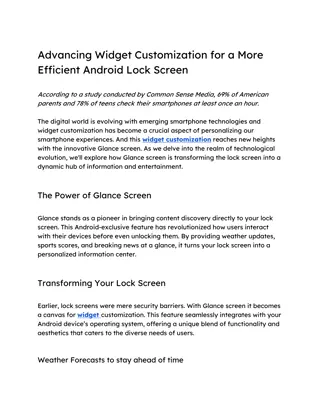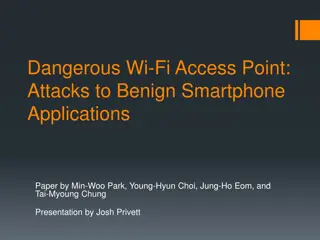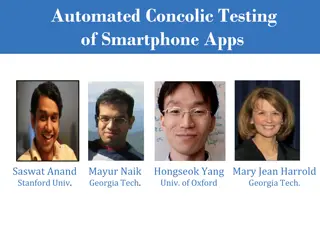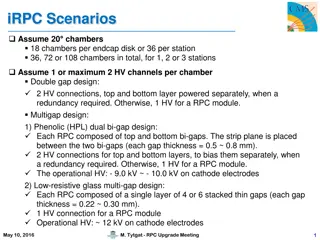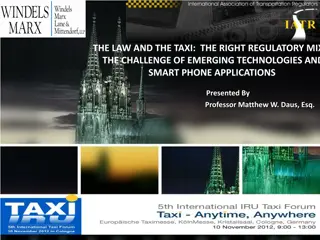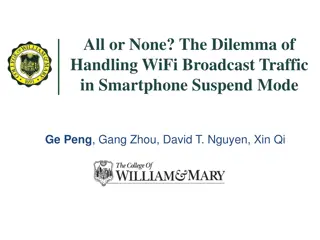Exploring 5G Smartphone RF Front End Technology
Delve into the world of 5G smartphone RF front end technology covering aspects like 4G/5G dual connectivity, path loss in radio links, frequency plan, channel capacity, front end architecture, MIMO modules, envelope tracking power amplifier, and more. Discover the features of 5G RF front end including wider channel bandwidth, HPUE, modulation techniques, and specific 5G bands. Explore the evolution and advancements in mobile connectivity for the future.
Download Presentation

Please find below an Image/Link to download the presentation.
The content on the website is provided AS IS for your information and personal use only. It may not be sold, licensed, or shared on other websites without obtaining consent from the author. Download presentation by click this link. If you encounter any issues during the download, it is possible that the publisher has removed the file from their server.
E N D
Presentation Transcript
Lecture 02a 5G Smartphone RF Front End Technology 1. 4G/5G Dual Connectivity 2. Path Loss in Radio Links 3. 4G/5G Frequency Plan 4. Channel Capacity 5. 4G/5G Front End Architecture 6. 5G RF Front End Features 7. 4G/5G Front End Module Architecture 8. MIMO Front End Module 9. Envelope Tracking Power Amplifier 10. Siliocon-On-Insulator Switch 11. Summary Acronyms 1
2. Path Loss in Radio Links - Path loss (PL): Loss of received power due to distance - 15-m height base-station to mobile path loss - Distance dependence: 1/R4 - Frequency dependence: Different for different propagation scenarios Outdoor-to-outdoor: 1/f 2 Outdoor-to-indoor: 1/f3 3
3. 4G/5G Frequency Plan - 5G NR (Newr Radio) bands are defined with prefix of "n". - n77/n78: 3.3-4.2 GHz, n79: 4.4-4.5 GHz - 5G UW, 5G UWB: Verizon's version of mmWave and mid-band 5G 4
3. 4G/5G Frequency Plan - iPhone 15 (2023-10-13 on the market) cellular and wireless functionality 5
3. 4G/5G Frequency Plan - License Assisted Access (LAA) 6
4. Channel Capacity - Shannon formula for channel capacity (bps) - ET (Envelope Tracking) 7
5. 4G/5G Front End Architecture - Ant: Antenna - AT: Attenuator - IT: Isolator - Coupler: Directional coupler - DRx: Diversity receiver - Tx: Transmit, transmitter - Rx: Receive, receiver - PMIC: Power management IC - Modem: Modulator-demodulator - UWB: Ultrawideband, 5G UW 8
6. 5G RF Front End Features - Wider channel bandwidth: Up to 100 MHz - HPUE (High Power User Equipment): 26 dBm = 400 mW - Modulation: 64-QAM, 256-QAM - 2 x 2 UL (Uplink) MIMO - New 5G dedicated bands for sub-6 GHz: n77/n78, n79 9
7. 4G/5G Front End Module Architecture - FEM: Front End Module - PA: Power Amplifier - SW: Switch - LNA: Low Noise AmplifierAnt: Antenna - MIPI-SPI: Mobile Industry Processor Interface - Serial Peripheral Interface 10
8. MIMO Front End Module - PSemi (a Murata company) PE188100 8-ch beamforming front end - TDD SW, PA, LNA, Splitter, Combiner, AT, Phase shifter, PD 12
11. Summary - Radio technology: As important as camera technology in smartphones - Why?: It determines the speed and cost of communications. - Why speed?: Huge data retrieval from servers for ever-evolving applications - Why cost?: Infrastructure cost, user device cost - RFFE: Active components: PA, LNA Passive components: SW, AT, IT, Coupler, Duplex Digital control - In semiconductor perspective: Analog IC, RFIC Major companies: Infineon, Qualcomm, Broadcomm (Avago) Qorvo, Skyworks, NXP, STMicro, Renesas 16
Acronyms 5G NR: Fifth Generation New Radio 5G UC: 5G Ultra Connectivity, low latency & high speed bps: bit per second, a unit for channel capacity or communication speed CA: Carrier Aggregation CMOS: Complementary Metal Oxide Semiconductor DL: Downlink DRx: Diversity Receiver DSP: Digital Signal Processing eMBB: Enhanced Mobile Broadband ET: Envelope Tracking FEM: Front-End Module FR1: Frequency Range 1 LAA: License-Assisted Access LNA: Low Noise Amplifier MCM: Multi-Chip Module MHB: Mid-High Band, n41 MIMO: Multiple Input Multiple Output MMB: Millimeter Wave Mobile Broadband 17
Acronyms mMTC: Massive Machine-Type Communications mmWave: Millimeter Wave, > 24 GHz or 30 GHz PA: Power Amplifier PMIC: Power Management Integrated Circuit RF: Radio Frequency SOI: Silicon On Insulator TDD: Time Division Duplex Tx: Transmitter UHB: Ultra-High Band, n77/n78, n79 UL: Uplink URLLC: Ultra Reliable Low Latency Communications UWB: Ultra-Wide Band USIM: Universal Subscriber Indentification Module V2X: Vehicle To Everything 18
